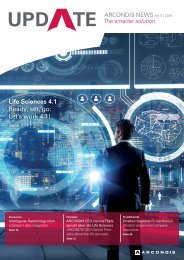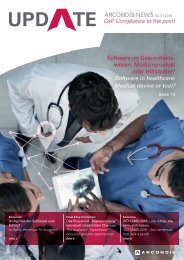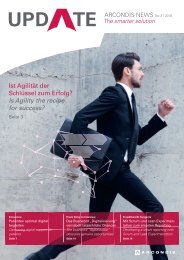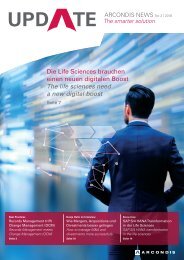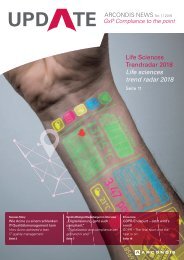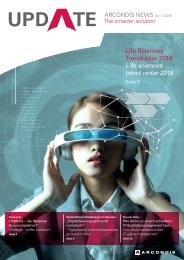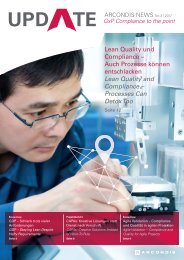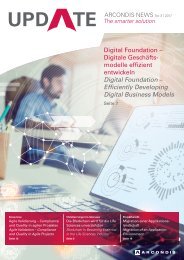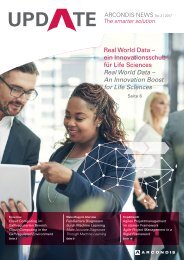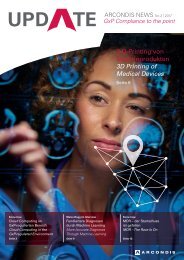ARCONDIS UPDATE No. 02|2019: The smarter solution
ARCONDIS Kundennewsletter für die Themenbereiche Business Applications und Compliance in Life Sciences Unternehmen
ARCONDIS Kundennewsletter für die Themenbereiche Business Applications und Compliance in Life Sciences Unternehmen
Create successful ePaper yourself
Turn your PDF publications into a flip-book with our unique Google optimized e-Paper software.
Jenny über ... Weshalb GMP nicht auf „doppelt hält besser“ setzt<br />
Jenny about ... Why two eyes are enough for the GMP<br />
Kolumne / Column<br />
D_In vielen Branchen hat sich das sogenannte<br />
Vier-Augen-Prinzip sowohl zur Vermeidung von<br />
Fehlern als auch zum Schutz vor Betrug etabliert.<br />
Die Good Manufacturing Practice (GMP)<br />
wählt hier aber einen anderen Weg.<br />
Mit dem stark ausgebauten Instrument der Qualifizierung<br />
von Anlagen und Räumen sowie der<br />
Validierung von Software und Prozessen kann die<br />
<strong>No</strong>twendigkeit der Doppelkontrolle im Idealfall gänzlich<br />
entfallen. Validierung und Qualifizierung ersetzen<br />
sozusagen das „zweite Augenpaar“.<br />
Die GMPRichtlinien fordern Kontrollen nach dem<br />
VierAugenPrinzip deshalb nur gezielt an wenigen<br />
Punkten, den sogenannten „kritischen“ Prozessschritten,<br />
die rein manuell durchgeführt werden<br />
müssen. Eine klassische Tätigkeit dieser Art ist die<br />
Kontrolle von Gewicht und Identität von Ausgangsstoffen<br />
– insbesondere von Wirkstoffen – beim<br />
Zusammenstellen der Rezeptur. Doch auch andere<br />
Prozesskriterien wie Temperatur, Druck, Zeitdauer<br />
oder Anlagenparameter können von so grosser Bedeutung<br />
für das Produkt sein, dass in den Vorschriften<br />
eine dokumentierte und damit nachweisbare<br />
Doppelkontrolle verlangt wird.<br />
Was heisst das aber für die Praxis der GMP? Das,<br />
was immer gefordert ist: die Analyse des Prozesses<br />
und ein entsprechendes Design von Abläufen, Vorgaben<br />
und Nachweisen. Es kann sinnvoll sein, das<br />
Einwiegen von Stoffen von zwei Personen vornehmen<br />
zu lassen. Alternativ kann man aber auch einen<br />
Drucker an die Waage anschliessen, der einen Beleg<br />
ausdruckt. Dann dient eben dieser Beleg als das<br />
zweite Augenpaar.<br />
Was aber nicht sein darf, ist das gedankenlose<br />
Einfügen von Kontrollschritten in die Abläufe. Ich<br />
erinnere mich an einen Fall, bei dem morgens<br />
um drei Uhr die Temperatur des Rührkessels vom<br />
Schichtmitarbeiter abgelesen und im Herstellprotokoll<br />
aufgezeichnet wurde. So weit, so gut. Doch im<br />
Protokoll war an dieser Stelle zusätzlich das Visum<br />
der Qualitätskontrolle vorgeschrieben. Dies erfolgte<br />
immer erst später durch eine Person, die bei der<br />
Temperaturablesung nota bene gar nicht anwesend<br />
sein musste – insgesamt aus GMPSicht ein komplett<br />
sinnloser Vorgang.<br />
Doppelkontrollen müssen immer plausibel und<br />
notwendig sein. Unsinnige Doppelunterschriften<br />
hingegen sind zu vermeiden, weil sie nicht nur keine<br />
zusätzliche Sicherheit bieten, sondern im Gegenteil<br />
sogar schaden. Es entstehen dadurch nicht nur Kosten<br />
und Aufwand, sondern es entwertet gleichzeitig<br />
das Instrument der Qualifizierung und Validierung.<br />
Als Prozessverantwortliche sagen Sie damit entweder<br />
„Wir misstrauen unseren Mitarbeitenden“ oder<br />
„Wir misstrauen der Validierung/Qualifizierung“ –<br />
beides definitiv nicht Ausdruck von „guter Praxis“.<br />
English<br />
E_<strong>The</strong> four-eyes principle has become a wellestablished<br />
requirement in many industries. It<br />
is intended to prevent both error and fraud. <strong>The</strong><br />
Good Manufacturing Practice (GMP) has chosen<br />
a different approach.<br />
In the best case, the well-developed instruments of<br />
system and room qualification and the validation of<br />
software and processes make second-level approval<br />
unnecessary. <strong>The</strong> validation and qualification essentially<br />
replace the second pair of eyes.<br />
That is why the GMP guidelines only require the<br />
four-eyes principle in very few, specific aspects:<br />
the ‘critical’ process steps that must be carried<br />
out manually. This includes typically controls of<br />
the weight and identity of source materials and<br />
especially active substances during compounding.<br />
But there are other process criteria – temperature,<br />
pressure, duration, system parameters – that can be<br />
so important to the product that the regulations demand<br />
a documented, demonstrable four-eyes check.<br />
What does this mean for GMP in practice? <strong>The</strong><br />
same requirements as always: a process analysis<br />
and the corresponding design of processes, specifications<br />
and recording. It can be useful to have two<br />
people weigh substances. Alternatively, a printer<br />
connected to the scales can print a document of<br />
evidence. In that case, the document replaces the<br />
second pair of eyes.<br />
What is unacceptable, however, is the thoughtless<br />
incorporation of additional control steps into the<br />
processes. I remember a case where a shift worker<br />
had to read the temperature of the stirrer tank at<br />
three o’clock in the morning and document it in the<br />
batch record. So far, so good. But the protocol also<br />
prescribed a second signature of this entry by a<br />
quality control officer. This step was carried out later<br />
by a person that did not even need to be present<br />
when the temperature reading was taken. From a<br />
GMP perspective, this sequence was completely<br />
pointless.<br />
Dual controls must be feasible and necessary. <strong>No</strong>nsensical<br />
double signatures ought to be avoided: not<br />
only do they offer no additional security, they are a<br />
security risk. Besides the additional cost and effort<br />
involved, dual checks devalue the status of qualification<br />
and validation. As a process owner you either<br />
convey distrust in your employees or in the validation/qualification<br />
status. Neither is an expression of<br />
good practice.<br />
Als ehemaliger stv. Direktor der<br />
Swissmedic ist Dr. Hans-Beat<br />
Jenny Experte in Sachen GxP<br />
und verfügt über jahrzehntelange<br />
Branchenerfahrung. Der promovierte<br />
Chemiker war lange Zeit in<br />
Forschung und Qualitätssicherung<br />
eines Basler Pharmakonzerns tätig,<br />
bevor er die Leitung des Heilmittelinspektorats<br />
der <strong>No</strong>rdwestschweiz<br />
und später den Bereich Bewilligungen<br />
in der Swissmedic übernahm.<br />
Seit seiner Pensionierung im Jahr<br />
2016 ist Jenny als Berater tätig.<br />
„Validierung und<br />
Qualifizierung<br />
ersetzen das zweite<br />
Augenpaar.“<br />
“Validation and<br />
qualification essentially<br />
replace the second pair<br />
of eyes.”<br />
As a former Deputy Director of<br />
Swissmedic, Dr. Hans-Beat Jenny<br />
is an expert on GxP matters and<br />
has decades of industry experience.<br />
For a long time, the chemist<br />
with a doctorate degree had<br />
been involved in the research and<br />
quality assurance of a Basel pharmaceutical<br />
company, before taking<br />
over management of the Drug<br />
Inspection Agency of <strong>No</strong>rthwestern<br />
Switzerland and later the Sector<br />
Licensing of Swissmedic. Jenny<br />
has been working as a consultant<br />
since his retirement in 2016.



